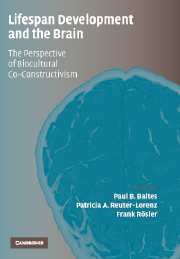Book contents
- Frontmatter
- Contents
- List of Contributors
- Preface and Acknowledgments
- Lifespan Development and the Brain
- PART ONE SETTING THE STAGE ACROSS THE AGES OF THE LIFESPAN
- PART TWO NEURONAL PLASTICITY AND BIOCULTURAL CO-CONSTRUCTION: MICROSTRUCTURE MEETS THE EXPERIENTIAL ENVIRONMENT
- PART THREE NEURONAL PLASTICITY AND BIOCULTURAL CO-CONSTRUCTION: ATYPICAL BRAIN ARCHITECTURES
- PART FOUR BIOCULTURAL CO-CONSTRUCTION: SPECIFIC FUNCTIONS AND DOMAINS
- 7 Language Acquisition: Biological Versus Cultural Implications for Brain Structure
- 8 Reading, Writing, and Arithmetic in the Brain: Neural Specialization for Acquired Functions
- 9 Emotion, Learning, and the Brain: From Classical Conditioning to Cultural Bias
- 10 The Musical Mind: Neural Tuning and the Aesthetic Experience
- PART FIVE PLASTICITY AND BIOCULTURAL CO-CONSTRUCTION IN LATER LIFE
- PART SIX BIOCULTURAL CO-CONSTRUCTION: FROM MICRO- TO MACROENVIRONMENTS IN LARGER CULTURAL CONTEXTS
- PART SEVEN EPILOGUE
- Author Index
- Subject Index
- References
9 - Emotion, Learning, and the Brain: From Classical Conditioning to Cultural Bias
Published online by Cambridge University Press: 17 July 2009
- Frontmatter
- Contents
- List of Contributors
- Preface and Acknowledgments
- Lifespan Development and the Brain
- PART ONE SETTING THE STAGE ACROSS THE AGES OF THE LIFESPAN
- PART TWO NEURONAL PLASTICITY AND BIOCULTURAL CO-CONSTRUCTION: MICROSTRUCTURE MEETS THE EXPERIENTIAL ENVIRONMENT
- PART THREE NEURONAL PLASTICITY AND BIOCULTURAL CO-CONSTRUCTION: ATYPICAL BRAIN ARCHITECTURES
- PART FOUR BIOCULTURAL CO-CONSTRUCTION: SPECIFIC FUNCTIONS AND DOMAINS
- 7 Language Acquisition: Biological Versus Cultural Implications for Brain Structure
- 8 Reading, Writing, and Arithmetic in the Brain: Neural Specialization for Acquired Functions
- 9 Emotion, Learning, and the Brain: From Classical Conditioning to Cultural Bias
- 10 The Musical Mind: Neural Tuning and the Aesthetic Experience
- PART FIVE PLASTICITY AND BIOCULTURAL CO-CONSTRUCTION IN LATER LIFE
- PART SIX BIOCULTURAL CO-CONSTRUCTION: FROM MICRO- TO MACROENVIRONMENTS IN LARGER CULTURAL CONTEXTS
- PART SEVEN EPILOGUE
- Author Index
- Subject Index
- References
Summary
ABSTRACT
Classical conditioning, described by Pavlov, has emerged as an important tool in our efforts to understand the mechanisms of emotional learning. Using a classical fear conditioning paradigm, research with nonhuman animals has identified the amygdala as a critical structure for emotional learning. This chapter reviews how studies in humans have extended the role of the amygdala to social means of emotional learning and culturally acquired race bias. Although cultural knowledge and some forms of social communication may be uniquely human characteristics, how emotional value is expressed in these domains seems to rely on basic mechanisms that are shared across species.
OVERVIEW
The basic principles of classical conditioning were identified by Ivan Pavlov more than a century ago when he showed that dogs would salivate to the ringing of a bell that had previously been paired with the delivery of food. More recently, investigators have used classical conditioning paradigms to help understand the neural mechanisms of emotional learning. These studies have focused on classical fear conditioning. In a typical fear conditioning paradigm, a neutral stimulus, called the conditioned stimulus (CS), is paired with an aversive event, the unconditioned stimulus (UCS). After a few pairings, the animal learns that CS predicts the UCS, and this previously neutral stimulus begins to elicit a fear response, called the conditioned response (CR). Using this paradigm, scientists studying nonhuman animals have been able to map the neural pathways of emotional learning from stimulus input to response output (see LeDoux, 2002, for a review).
Information
- Type
- Chapter
- Information
- Lifespan Development and the BrainThe Perspective of Biocultural Co-Constructivism, pp. 200 - 216Publisher: Cambridge University PressPrint publication year: 2006
References
Accessibility standard: Unknown
Why this information is here
This section outlines the accessibility features of this content - including support for screen readers, full keyboard navigation and high-contrast display options. This may not be relevant for you.Accessibility Information
- 3
- Cited by
